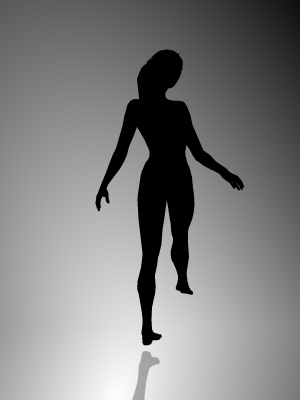This popular illusion created by Nobuyuki Kayahara in 2003, shows the spinning silhouette of a female dancer. If the viewer’s perception is that the foot touching the floor is the left foot, then the dancer appears to be spinning in a clockwise direction. If the foot touching the floor is perceived to be the right foot, then the dancer seems to be spinning in a counterclockwise direction. However, it is possible for the same viewer to see the dancer spinning in BOTH clockwise and counterclockwise directions. The change in direction can sometimes be observed after blinking or by focusing on a specific part of the image.
After conducting an online survey, Munger (2008) reports on a puzzling find:
While the illusion can’t actually determine whether you’re “right-brained” or “left-brained,” we were curious about what actually affects people’s perception of the illusion. Over 1,600 readers took our online survey about the illusion. What’s interesting about the illusion is that it’s ambiguous — it can appear to be spinning both clockwise and counter-clockwise… roughly two-thirds of viewers initially saw it spinning clockwise, while a third saw it spinning counter-clockwise. About two thirds of viewers were able to reverse the direction of rotation from clockwise to counter-clockwise or vice-versa. Interestingly, this ability was affected by the initial direction of motion…If you saw the figure spinning counter-clockwise first, then you were significantly more likely to be able to reverse the direction of rotation than if you saw it spinning clockwise first. This makes some sense, since more people see it rotating clockwise — it may be that there’s a natural tendency to see it spinning that way, which means it’s more difficult to reverse from clockwise to counter-clockwise than the other way around.
How is it even possible for us to see a single image rotating in opposite directions? Well, due to the image’s lack of visual cues for depth, the ambiguous 2-dimensional figure can be seen from two different perspectives. This alternation between two perceptual states is referred to as bistable perception. The illusion’s inherent visual ambiguity presents our visual systems with two different interpretations of the same stimulus, as opposed to the one unique interpretation we are more accustomed to in everyday life. By using simple techniques such as blinking rapidly, narrowing visual focus or even tilting our head, we might be able to switch from one perspective to the other.
Reference
Munger, D. (2008). Casual fridays: Tk-421, why can’t you spin that woman in reverse? Cognitive Daily. Retrieved on April 25, 2012 from http://scienceblogs.com/cognitivedaily/2008/10/casual_fridays_tk421_why_cant.php


